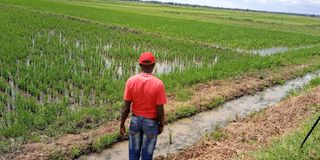Butaleja farmers appeal to govt over low prices for rice

A man stands near rice gardens in Doho Rice Scheme, Mazimasa Sub-county in Butaleja District. PHOTO/Yahudu Kitunzi
What you need to know:
The district is also home to Doho Rice Scheme, one of the biggest in the country.
Rice production remains the most popular economic activity in Butaleja District, eastern Uganda.
The district is also home to Doho Rice Scheme, one of the biggest growing schemes of the cereal in the country.
Despite this, many rice farmers have remained poor and struggle to meet basic economic needs, including paying school fees for their children.
This is partly due to low prices the rice fetches.
Local leaders say poor yields and poor harvest handling of Kaiso rice, which is the only variety grown in the district, gives room for importation of rice from other countries, including Tanzania.
Most farmers dry their rice on bare ground, which affects its quality.
The farm gate price for a kilogramme of Kaiso rice is Shs1,800 and the retail price is Shs2,500.
Shrewd traders from Kenya and other parts of Uganda usually buy unprocessed rice from the district, refine it and then resell at Shs6,000 per kg.
Ms Madina Namudira, a rice farmer, says they are exploited by middlemen because sometimes they cannot even store their produce for the prices to stabilise because of pressing needs.
“We are being cheated. We know it but we have no option. They sometimes pay us as low as Shs1,500 per kilogramme,” she says.
Ms Sarah Lugose, another farmer, says the current market prices are demotivating.
“The low price has demotivated us to continue growing rice and yet it’s the only source of income. We appeal to the government to get good market for our rice,” Ms Lugose says.
Mr Peter Haduhulu, a rice trader, says they do not have capital to add value to their rice and also to improve post-harvest handling such as advanced methods of drying it.
“We also don’t have financial support to brand our rice in order to fetch good prices,” Mr Haduhulu says.
Mr Muhammad Wandera, a resident of Nampologoma Trading Centre, blamed the low prices on failure to get market outside their district.
“Our leaders are not helping us to attract the market and grade the rice,” Mr Wandera says.
The district chairperson, Mr Micheal Higenyi Bory, says rice, which is imported from Tanzania, is graded, packaged and branded.
“Here we don’t do any of that. Some farmers dry their rice on the bare ground, which compromises the quality of rice,” Mr Higenyi says.
The district environmental officer, Mr Tom Wandera, reveals that whereas Butaleja remains the top rice producer in the country with about 150,000 tonnes per year, there is little profit for the farmers.
“Most households have remained in perpetual poverty due low prices associated with various reasons, which include poor post-harvest handling where farmers thresh rice by using heavy sticks instead of a thresher,” he says.
Mr Wandera explains that poor threshing leaves most of the rice particles broken. “The drying method by our farmers doesn’t conform to the three hours per day recommended standard; instead farmers expose rice to all day sunshine, which affects the final product,” he adds.
He says poor storage also accounts for poor quality as most milling places do not have recommended stores and capacity to handle large volumes of rice.
“Ninety percent of Butaleja rice is milled by one stage mill fabricated locally; this affects output and quality as farmers record a high percentage of broken rice, which fetches low prices,” he says.
Mr Wandera also blames poor prices on the lack of aggregation centres.
“Each farmer sells their own rice at their own time and quantity and this affects their bargaining power,” he says.
Mr James Wire, an agribusiness consultant, says rice prices have remained low but the government has also done little to help.
“We have shouted ourselves hoarse about the need to have better quality rice on the market but the farming community and government doesn’t give a hoot,” Mr Wire says. Mr Wire also reveals that whereas government set up mills in the district that grade rice nearly 10 years ago, many farmers shunned them, claiming the machines reduces the quantity of the cereal.
“Now they are the same that are complaining of low prices yet if we had kicked off Brand Butaleja while associating it with clean rice, today we would be selling with ease at premium rates. A lot of the Pakistan rice that retails at more than Shs5, 000 has never fallen in price despite the flooded market,” he says.
However, Mr David Mulabi, the former contestant for Bunyole East parliamentary seat, blames high poverty levels on the lowest returns on their investment in rice.
“The trader who moves from one place to another without any other input gets Shs2,000 per kilo as profit. So poor returns in the sector mean high poverty levels,” Mr Mulabi says.
Rice in Butaleja
Rice growing gained prominence in the 1970s following the establishment of the Doho Rice scheme by the government. Doho rice scheme has more than 2,500 acres of land and more than 9,000 farmers involved. Other schemes and swamps where rice is grown include Lwoba irrigation scheme, Nakwasi swamp, Hijjinji swamp, Wampala swamp, Namatala swamp, Mpologoma, Nkawiga, Nahinghande, Doho-Hibira.





